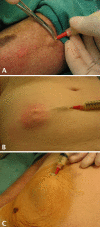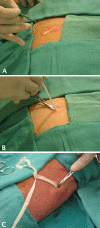A skin abscess model for teaching incision and drainage procedures
- PMID: 18598345
- PMCID: PMC2453116
- DOI: 10.1186/1472-6920-8-38
A skin abscess model for teaching incision and drainage procedures
Abstract
Background: Skin and soft tissue infections are increasingly prevalent clinical problems, and it is important for health care practitioners to be well trained in how to treat skin abscesses. A realistic model of abscess incision and drainage will allow trainees to learn and practice this basic physician procedure.
Methods: We developed a realistic model of skin abscess formation to demonstrate the technique of incision and drainage for educational purposes. The creation of this model is described in detail in this report.
Results: This model has been successfully used to develop and disseminate a multimedia video production for teaching this medical procedure. Clinical faculty and resident physicians find this model to be a realistic method for demonstrating abscess incision and drainage.
Conclusion: This manuscript provides a detailed description of our model of abscess incision and drainage for medical education. Clinical educators can incorporate this model into skills labs or demonstrations for teaching this basic procedure.
Figures



Similar articles
-
Teaching Incision and Drainage: Perceived Educational Value of Abscess Models.Pediatr Emerg Care. 2018 Mar;34(3):174-178. doi: 10.1097/PEC.0000000000001240. Pediatr Emerg Care. 2018. PMID: 28719482
-
A low-cost high-fidelity model for abscess simulation.Am J Surg. 2020 Apr;219(4):628-631. doi: 10.1016/j.amjsurg.2019.06.011. Epub 2019 Jun 19. Am J Surg. 2020. PMID: 31253352
-
Primary Care Management of Skin Abscesses Guided by Ultrasound.Am J Med. 2017 May;130(5):e191-e193. doi: 10.1016/j.amjmed.2016.11.040. Epub 2016 Dec 22. Am J Med. 2017. PMID: 28012823
-
Point-of-care Ultrasound for Diagnosis of Abscess in Skin and Soft Tissue Infections.Acad Emerg Med. 2016 Nov;23(11):1298-1306. doi: 10.1111/acem.13049. Epub 2016 Nov 1. Acad Emerg Med. 2016. PMID: 27770490 Review.
-
A systematic review and meta-analysis of incision and seton drainage in the treatment of high perianal abscess.Ann Palliat Med. 2021 Sep;10(9):9830-9840. doi: 10.21037/apm-21-2229. Ann Palliat Med. 2021. PMID: 34628909
Cited by
-
Evaluation of Outpatient Procedures Simulation Curriculum for Internal Medicine Residents.J Gen Intern Med. 2025 Jun;40(8):1782-1788. doi: 10.1007/s11606-025-09394-w. Epub 2025 Feb 25. J Gen Intern Med. 2025. PMID: 40000517
-
Which Way Would You Slice It? Evaluation of 3 Educational Models for the Loop Drainage Technique.Med Sci Educ. 2022 Mar 23;32(2):481-494. doi: 10.1007/s40670-022-01530-z. eCollection 2022 Apr. Med Sci Educ. 2022. PMID: 35528288 Free PMC article.
-
Cadaver-based abscess model for medical training.Adv Med Educ Pract. 2017 Jan 18;8:85-88. doi: 10.2147/AMEP.S124648. eCollection 2017. Adv Med Educ Pract. 2017. PMID: 28176889 Free PMC article.
References
-
- Meislin HW, Lerner SA, Graves MH, McGehee MD, Kocka FE, Morello JA, Rosen P. Cutaneous abscesses. Anaerobic and aerobic bacteriology and outpatient management. Ann Intern Med. 1977;87:145–149. - PubMed
Publication types
MeSH terms
LinkOut - more resources
Full Text Sources
Medical

